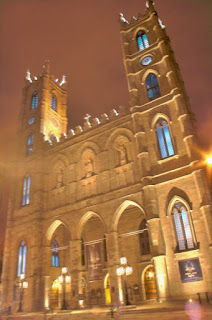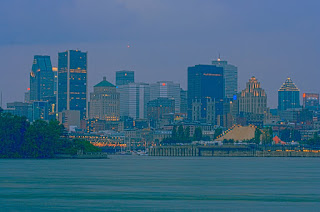In image processing, computer graphics and photography, high dynamic range imaging (HDRI) is a set of techniques that allows a greater dynamic range of exposures (the range of values between light and dark areas) than normal digital imaging techniques. The intention of HDRI is to accurately represent the wide range of intensity levels found in real scenes ranging from direct sunlight to shadows.
High Dynamic Range Imaging was originally developed in the 1930s and 1940s by Charles Wyckoff. Wyckoff's detailed pictures of nuclear explosions appeared on the cover of Life magazine in the early 1940s. The process of tone mapping together with bracketed exposures of normal digital images, giving the end result a high, often exaggerated dynamic range, was first reported in 1993[1], and resulted in a mathematical theory of differently exposed pictures of the same subject matter that was published in 1995[2]. In 1997 this technique of combining several differently exposed images to produce a single HDR image was presented to the computer graphics community by Paul Debevec.
This method was developed to produce a high dynamic range image from a set of photographs taken with a range of exposures. With the rising popularity of digital cameras and easy-to-use desktop software, the term "HDR" is now popularly used[3] to refer to this process. This composite technique is different from (and may be of lesser or greater quality than) the production of an image from a single exposure of a sensor that has a native high dynamic range. Tone mapping is also used to display HDR images on devices with a low native dynamic range, such as a computer screen.
Comparison with traditional digital images
Information stored in high dynamic range images usually corresponds to the physical values of luminance or radiance that can be observed in the real world. This is different from traditional digital images, which represent colors that should appear on a monitor or a paper print. Therefore, HDR image formats are often called "scene-referred", in contrast to traditional digital images, which are "device-referred" or "output-referred". Furthermore, traditional images are usually encoded for the human visual system (maximizing the visual information stored in the fixed number of bits), which is usually called "gamma encoding" or "gamma correction". The values stored for HDR images are often linear, which means that they represent relative or absolute values of radiance or luminance (gamma 1.0).
HDR images require a higher number of bits per color channel than traditional images, both because of the linear encoding and because they need to represent values from 10−4 to 108 (the range of visible luminance values) or more. 16-bit ("half precision") or 32-bit floating point numbers are often used to represent HDR pixels. However, when the appropriate transfer function is used, HDR pixels for some applications can be represented with as few as 10–12 bits for luminance and 8 bits for chrominance without introducing any visible quantization artifacts.[4]
Synthetic HDR images
Computer-created HDR images were first produced with various renderers, notably Radiance.[citation needed] This allowed for more realistic renditions of modelled scenes because the units used were based on actual physical units e.g watts/steradian/m². It made it possible for the lighting of a real scene to be simulated and the output to be used to make lighting choices (assuming the geometry, lighting, and materials were an accurate representation of the real scene).
At the 1997 SIGGRAPH, Paul Debevec presented his paper entitled "Recovering High Dynamic Range Radiance Maps from Photographs".[5] It described photographing the same scene many times with a wide range of exposure settings and combining those separate exposures into one HDR image. This HDR image captured a higher dynamic range of the viewed scene, from the dark shadows all the way up to bright lights or reflected highlights.
A year later at SIGGRAPH '98, Debevec presented "Rendering Synthetic Objects into Real Scenes: Bridging Traditional and Image-Based Graphics with Global Illumination and High Dynamic Range Photography".[6] In this paper he used his previous technique to photograph a shiny chrome ball to produce what he called a "light probe", essentially an HDR environment map. This light probe could then be used in the rendering of a synthetic scene. Unlike a normal environment map that simply provides something to show in reflections or refractions, the light probe also provided the light for the scene. In fact, it was the only light source. This added an unprecedented level of realism, supplying real-world lighting data to the whole lighting model.
HDRI lighting plays a great part in movie making when computer 3D objects are to be integrated into real-life scenes.[citation needed]
[edit]Tone mapping
One problem with HDR has always been in viewing the images. Typical computer monitors (CRTs, LCDs), prints, and other methods of displaying images only have a limited dynamic range. Thus various methods of converting HDR images into a viewable format have been developed, generally called "tone mapping".
Early methods of tone mapping were simple. They simply showed a "window" of the entire dynamic range, clipping to set minimum and maximum values. However, more recent methods have attempted to compress the dynamic range into one reproducible by the intended display device. The more complex methods tap into research on how the human eye and visual cortex perceive a scene, trying to show the whole dynamic range while retaining realistic colour and contrast.
Images with too much "HDR" processing have their range over-compressed, creating a surreal low-dynamic-range rendering of a high-dynamic-range scene.
[edit]Image Sensors
CMOS image sensors are now capable of creating HDR images up to 110dB, for chips up to 2mp, and form factors of 1/5", immediately, for low cost in contrast to extremely costly CCD sensors.
Sensors can produce HDR images inherently and seamlessly.
[edit]Exposure examples
Here the dynamic range of the image is demonstrated by adjusting the "exposure" when tone-mapping the HDR image into an LDR one for display. The above sequence uses an image rendered with Radiance using Paul Debevec's light probe of the Uffizigallery. The rendering software produces a high dynamic range image. When making the JPEG images, one selects a part of that range for display. This is similar to how a conventional camera captures only a portion of the dynamic range of a real physical scene.
The middle exposure is the desired exposure and is likely how this scene would normally be presented. The exposure to the left is 4 EV darker, showing some detail in the bright clouds in the sky. The exposure to the right is 3 EV lighter, showing some detail in the darker parts of the scene. This shows why compositing is desirable; a composite image can retain the interesting details from all three exposure settings.






































